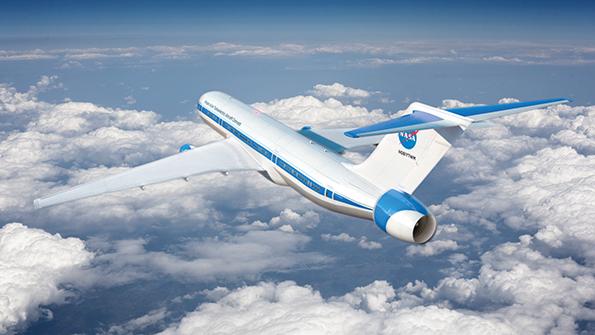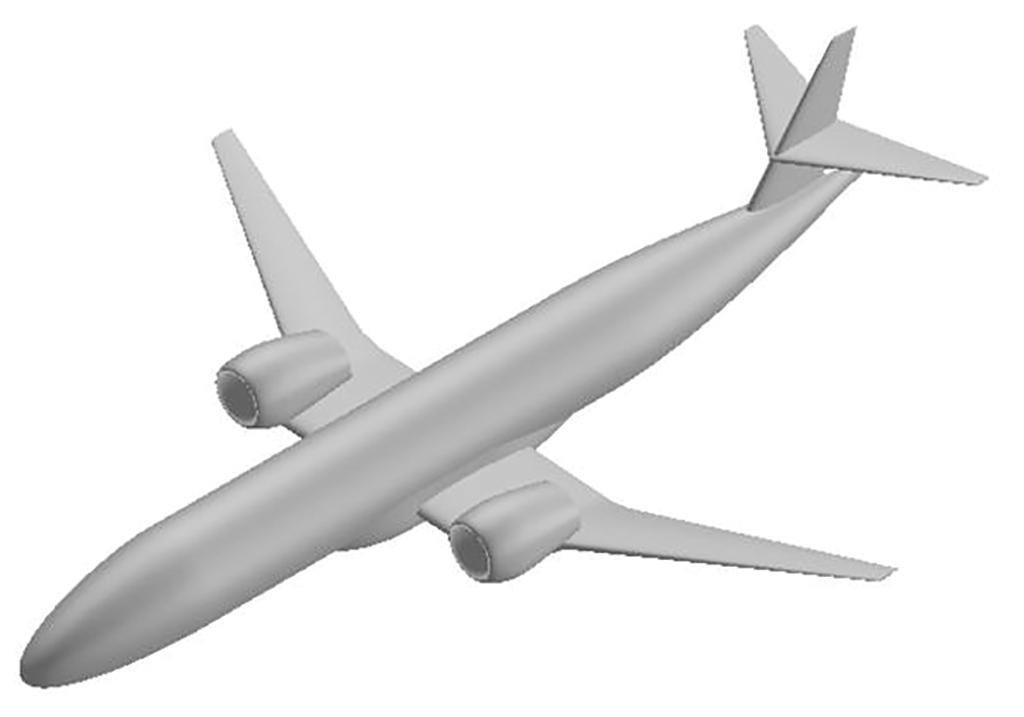
As world leaders prepare to gather Oct. 31 at the United Nations COP26 climate change conference in Scotland, NASA is planning to launch a new technology initiative aimed at a future airliner with potentially zero environmental impact.

Targeting concept studies for a 2040-plus entry-into-service (EIS) time frame, the project is in its formative stages and comes as the research agency gets set to issue proposals to industry for a nearer-term ultraefficient X-plane sustainable airliner technology demonstrator later this decade.
“We’re already in conversations with industry, and we’ll do a request for information probably later this fiscal year,” says Jim Heidmann, Advanced Air Transport Technology (AATT) manager at NASA’s Glenn Research Center in Cleveland. “A request for proposals is envisioned for [fiscal 2023]. Those are to define the technologies required for an aircraft in the 2040s, and part of it is, what do we need by then? Is it zero carbon emissions or is it zero environmental impact?”
- Requests for proposals due in fiscal 2023
- Targeted at entry into service from 2040 onward
The long-term plan is intended to take a step further than the upcoming sustainable flight demonstrator (SFD) X-plane, which is expected to start flight tests in 2026 and is aimed at maturing key airframe-focused technologies for introduction of future single-aisle airliners by 2035. The X-plane forms an element of NASA’s Sustainable Flight National Partnership (SFNP) plan with other agencies, industry and academia, and builds on a series of subsonic transport studies reaching back to the mid-2000s.
Outline targets for the new concept studies will leverage a multigenerational construct formulated at the creation of NASA’s Subsonic Fixed Wing (SFW) project in the 2005-20 time frame. Dubbed N+, the concept helped identify and drive innovation for multiple time frames targeting noise, emissions and fuel burn. Nearer-term N+1 studies focused on concepts for a conventional tube-and-wing airliner with technology ready to transition to full-scale development in the 2015 time frame.
Targets for N+2, which aimed at entry into service in the 2020s, were set relative to a GE90-powered Boeing 777. These included a noise goal of –42 dB below Stage 4, landing and takeoff NOx emissions 75% below CAEP 6 limits and at least a 40% reduction in fuel burn. More ambitious goals were also set for N+3—an advanced airliner concept ready to enter service in the 2030s.
SFW, which is today known as the AATT project, also spun off the Environmentally Responsible Aviation (ERA) project, begun in 2010 to pursue integrated demonstrations focused on the N+2 service-entry period. Unlike earlier studies, ERA was notable for challenging industry and researchers to come up with concepts that simultaneously met tough noise, emissions and fuel goals rather than traded these parameters to meet overall mission targets.

“Think of it as N+4—but we’re calling it the 2040+ EIS concept studies project,” Heidmann says. “Part of it is not just necessarily reducing fuel burning but looking at the bigger picture.” These studies extend beyond the remit of new airframe, propulsion and systems concepts to include new areas such as hydrogen and other sustainable aviation fuels. “They are not going to be mandated, but it will be things that can get you to more ambitious environmental targets, as well as all the aircraft and engine technologies as we typically do,” he adds.
The 2040-plus concept study plan “sets the stage for a whole other initiative,” says Heidmann, who acknowledges the role the SFW/AATT and ERA constructs have played in paving the way for NASA’s newest X-plane. “Let’s push a little further and do this again. It’s a nice model.”
For the moment, no specific performance or emission-reduction goals are being revealed, though Heidmann says the targets outlined in NASA’s Strategic Implementation Plan (SIP) for subsonic transports are aimed at approximately the 2040s time frame. These include cumulative noise reductions of as much as 52 dB below Stage 4; landing and takeoff NOx emissions of more than 80% below CAEP 6; cruise NOx emissions of more than 80% below best-in-class aircraft from 2005, and up to 80% lower fuel/energy consumption relative to the same 2005 standard.
“For this one we want to ask industry what is needed. We don’t want to just march blindly into this,” he adds. “We want to assess what’s going to be required in the 2040s, and industry can help frame that for us in terms of what we’re going to ask for those needs. I think firm targets are going to come out of those industry interactions.”
That approach will allow for potential step changes in power, fuel and propulsion technologies to be integrated into the concept studies. “There could be a breakthrough on hydrogen or in some other technology. Batteries could make a major leap in capabilities, for example,” Heidmann says. “So, we want to be ready for what could be out there to make a big jump in reducing carbon emissions and environmental impact.”

Although hydrogen fuels and power-related technologies are likely to be studied in the 2040-plus program, NASA has not formalized its research approach for that arena. “There’s a lot of interest, especially in Europe, and we’re still kind of assessing what [that means]. We’ve seen the Airbus concepts,” Heidmann says. “On the space side of NASA there are cryogenic capabilities in terms of tankage and so forth, so there are some capabilities we can leverage if that becomes an area of interest. We also want to talk about the infrastructure challenges with hydrogen, so that’s something that we need to deal with.”
The studies may also include more electrified and hybrid-electric concepts for larger aircraft, some of which may be explorable under the spiral upgrade capabilities being planned for the SFD X-plane. “However, that is still a challenge for larger aircraft,” notes Heidmann. “Right now we’re focused on single-aisle transports [with the SFD], but for the next one I think we’re more open on what size class it should be,” he adds. “It could be bigger, or it could be smaller. It could be whatever the market is demanding in that time frame. So, I think we’re going to stay a little flexible on the class of aircraft for now.”
The new N+4 work will also include participation from researchers involved in NASA’s University Leadership Initiativ—a plan under which U.S. universities receive NASA funding and take the lead in building their own teams and setting their own research agenda with goals that complement the agency’s Aeronautics Research Mission Directorate and its SIP.
The new study may also revisit aspects of more futuristic technologies first evaluated by NASA, Boeing and others in the SFW N+3 Advanced Concept Study starting as far back as 2008. These included multifunctional lightweight structures and electrified aircraft propulsion systems, as well as new shapes such as the high-aspect ratio Transonic Truss-Braced Wing (TTBW) concept studied with Boeing. It is this design that Boeing will propose for the sustainable X-plane contract.
Boeing also evaluated possible N+4 technologies in 2011 as part of its work with NASA on the Subsonic Ultra Green Aircraft Research (SUGAR) project. The broad-ranging effort also included studies of a 2040-era airliner design incorporating several advanced aerodynamic and propulsion technologies. These included liquefied natural gas, hydrogen, fuel cell and battery electric hybrids, low-energy nuclear, boundary layer ingestion, unducted fans and advanced propellers.
NASA says that, following a planned first flight in late 2026, the SFD research campaign will last for six months and be completed in 2027. Ground test and flight research data from the SFD will be used to measure the winning contractor’s “vision system” performance relative to a set of midterm performance objectives set by NASA for future subsonic transport aircraft in the 2025-35 time frame.
These call for technology readiness levels of 5 to 6 (ready to transition to production development), for an aircraft capable of cumulative noise levels of 32 dB to 42 dB below Stage 4. Other targets for NOx emissions, fuel burn and energy consumption are in line with the SIP targets.
The agency has already outlined plans to conduct detailed studies of Boeing’s high-efficiency TTBW configuration under the broader aims of the SFNP, but says the sustainable demonstrator configuration depends on the proposals it receives from industry. Under SFNP, NASA also plans to demonstrate a high-power hybrid-electric propulsion system for large transport aircraft; composites structures capable of being produced at 4-6 times the rate possible with current technology; and small-core turbine engines with high thermal efficiency. The X-plane would integrate these technologies and validate the benefits.
Plans for the 2040-plus concept studies and sustainable flight demonstrator emerge as NASA enters a period of increasing tempo for flight testing new propulsion systems and supersonic technology. In addition to the sustainable X-plane plan, the agency is working with industry teams selected for the Electric Powertrain Flight Demonstration program and is building up to begin flights in 2022 of the X-59 low-boom supersonic flight demonstrator and X-57 distributed electric propulsion demonstrator.
Editor's note: This article has bee updated to include new information about NASA's N+ concept studies.





